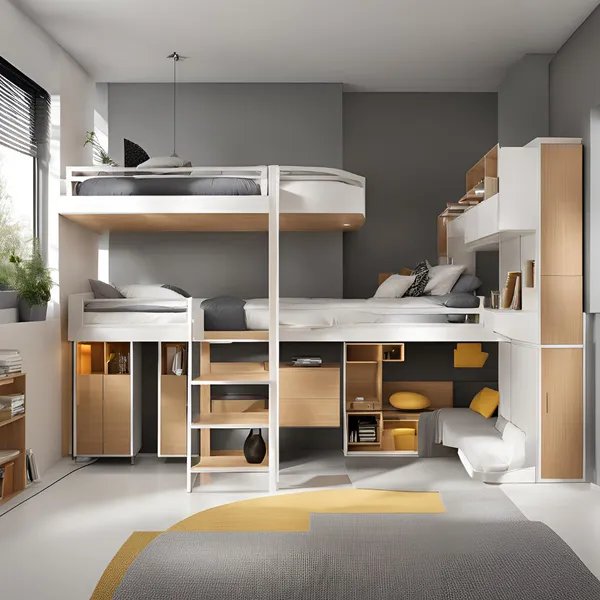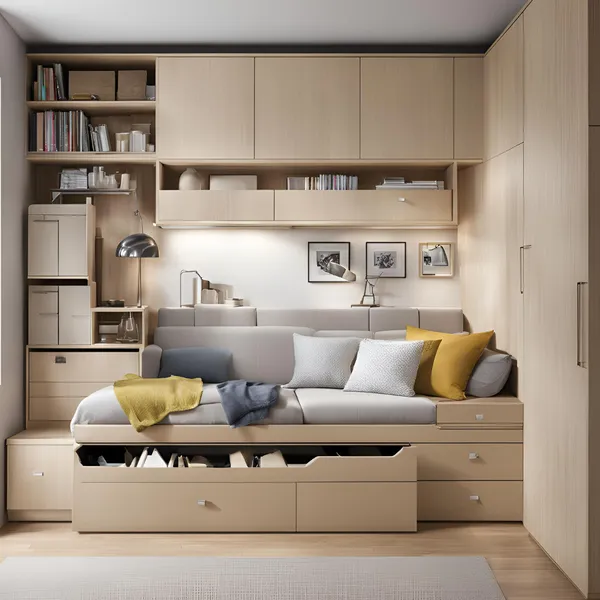Designing a multi-functional space is an exciting challenge. It is simply a matter of optimizing available space in a room while creating comfort and style out of the available area.
Whether working with a small apartment, a home office, or just a corner of your living room, knowing how to design a multi-functional space can help you create a space that works harder for you. Now, let’s move on to how you can begin!
Why Design a Multi-Functional Space?
In our buildings, we require flexibility, the ability to perform more than one function within 24 hours.
Here are a few reasons why designing a multi-functional space is a great idea:
- Maximize Limited Space: It is important in apartments, smaller homes, or offices. A multi-functional design enables you to use one area for several tasks.
- Better Organization: Having multifunctional room arrangements makes people more cautious while factoring in space for storage and everything else. This can maintain the order and organization of one’s space.
- Adaptability: The world is dynamic, and so are people’s needs. A multi-functional space can easily evolve as your circumstances change.
Key Features of a Multi-Functional Space
A well-designed multi-functional space includes several important features:
- Flexible Furniture: This is furniture that is rolled, rotated, or folded to meet the task at hand and, just as easily, rearranged.
- Smart Storage Solutions: Ways of creatively arranging items to help keep your environment neat.
- Defined Zones: While living in a compact place, one can divide the area to work, to sleep, and just to relax at the appointed time.
- Aesthetic Consistency: ALT text: Even if the room is multifunctional, this should not look clear, and every element should be visually appealing.
How to Design a Multi-Functional Space
Step 1: Plan Your Space Layout

When designing a multi-functional space, the layout is crucial. Consider how the space is utilized in use or day-to-day business to offer a solution. Ask yourself:
What are the primary functions this space needs to serve?
How many acres, sq. m or sq ft, would be ideal for each function?
Where are you most often?
How to Create Defined Zones
It’s important to define different zones without walls or partitions in a multi-functional space. Here’s how you can do it:
- Use Furniture to Define Areas: For instance, a sofa divides a living space from a working space. This makes a bookcase useful as it can be a visual divider between the bedroom and the office.
- Area Rugs: Use rugs to define some areas. Location: A rug under the dining table can also aid in providing dining sectionalization in a lounge area or work desk, among others.
- Lighting: Various lighting informs different zones, As it can be viewed from the different types of lighting. For instance, task lighting ensures that your working area is well-lit and that a particular area is lit with a certain ambiance for living space.
Make It Flow
When organizing the zones, you want one to transition from the next seamlessly. Refrain from filling any corner of the room, as this will only tend to clutter up the room and make it appear congested.
Ensure sufficient space between two areas, and ensure that one area leads smoothly to another activity.
Step 2: Decision to choose Multi-Functional Furniture

Furniture is the backbone of any multi-functional space. The correct selections of these pieces will enable one to organize space optimally. Here are some ideas for versatile furniture:
- Convertible Sofas and Beds
A sofa bed is good for a living space for occasional guests’ sleeping.
Murphy beds are designed to fold over the wall and provide usable floor space when not operational.
- Fold-out Desks and Tables
An example of convertible furniture is a folding desk, which can be ideal if you work from home for part of the day.
These extend for eating purposes and are folded back in case there is a need for other uses later on.
- Storage Ottomans
Some of them can act as sofas and, at the same time, coffee tables in which you can store blankets, magazines, or toys when not in use.
- Modular Storage Units
Flexible joinery, which refers to modular shelving, is easily interchangeable, and storage cubes may accommodate various objects.
- Nesting Tables
In particular, nesting tables give more than needed and thus more space but are easily storable when not needed.
Step 3: Use Smart Storage Solutions

In a multi-functional space, storage is key. If not, the place will be congested and chaotic within a blink of an eye. Here are some clever ideas to keep your home organized:
- Vertical Storage
Why not go up if you feel an acute shortage of free space on the floor? Because people only access things high on the walls occasionally, consider putting the shelves in those areas to store books, decorations, or additional utensils.
- Under-Bed Storage
If you don’t have a lot of space for your clothes, use under-bed storage for clothes you wear during different seasons, bedding, or even your working documents.
There are convenient features that make storage bins or drawers easily slide under your bed for storage convenience.
Lofted beds effectively develop more space below for a desk or any sitting enclosure.
- Hidden Storage
Incorporate furniture that hides storage in plain sight:
- Tables with additional space underneath their top are perfect for placing, for example, remotes, books, or blankets.
- Ottomans are a great addition to any large room as they can be used to put away magazines, toys, or anything else one would like stored out of sight but within easy reach.
- Closet Organizers
Maximize closet space by using:
- Hooks for shoes, bags, or scarves that hang on the wall.
- Shelving with trays that nest one on top of the other to store related small items.
Step 4: Optimize Lighting

Lighting can transform a multi-functional space. It not only contributes to the making of the environment beautiful but also helps to make one part of the building or space more useful than the other.
Types of Lighting to Consider
- Ambient Lighting: For this, consider the lighting used to light up the entire space in the room. Ceiling types of light or floor lamps would do well here.
- Task Lighting: If you are doing something specific, such as reading, working, or cooking, you require directional light. Such uses call for desk lamps, pendants, and under-cabinet lights.
Accent Lighting: You should illuminate certain things in your space, for instance, artwork, plants, or bookshelves. This is the case with track lighting or spotlights.
Lighting Tips for Multi-Functional Spaces
- Layer Your Lighting: Ideally, integrate all three kinds of light: general, local, and task.
- Adjustable Fixtures: The location should have normal lighting installed to change the intensity depending on what’s happening.
Step 5: Select a Consistent Design Theme
While a multi-functional space needs to serve different purposes, you also want it to look cohesive. A consistent design pattern when choosing furniture and accessories will bring that orderliness.
Choosing a Design Theme
Choose a color scheme that will tie all the things together properly. It doesn’t necessarily have to be one color; however, using colors complementing one another makes the area look more solid.
For example:
Beige, grey, and white colors give plainers, and you can complement them with the colors of the throw, rugs, and picture frames.
To add more style, you may apply an accent color on walls or just order pieces of furniture that are distinctively different in different types of interior design,includinge multi-functional design styles whereby furniture serves multiple functions.
Scandi design emphasizes simplicity and functionality, making it a great fit for small, multi-functional spaces.
Being selective with what you bring into a room dramatically reduces clutter, and the basic premise of minimalism has been shown to make it far easier to keep an area tidy.
The industrial design makes open shelves and utilizes raw materials to provide the industrial aesthetic and functionality possible.
Step 6: Adapt for Different Needs
The beauty of a multi-functional space is that it can evolve as your needs change. They may then convert a home office into a guest or family room into a workout area.
Fast Facts for Changing Your Surrounding
- Use room dividers: Blinds or curtains, mobile or even operable walls, can quickly and accurately divide spaces without structural alterations.
- Seasonal Changes: Replace accessories, paneling, a couch, curtain, rug, carpet, or any interior object per the changing seasons.
- Technology Integration: Connective smart home devices to light control, audio, or voice control to allow you to control the environment of the house easily.
Conclusion:
Designing a space that will work for occupants is one of the most important aspects of architecture.
Designing a multi-functional space is about thinking creatively and using your space to make life easier.
A well-coordinated design of how the space is laid out and what kind of furniture, storage, lighting, and design employed can result in more than one functional area without squeezing the room to its limits. The space should be versatile whether you’re in the office, exercising, or with family and friends.
So, are you ready to design your multi-functional space? It’s time to begin and prepare for getting the most from your space. Indeed, with the help of such tips and with some effort used in imagination, you can
Meet any space transformation needs and make any room a workspace AND a play space!